Optimising chickpea sowing and flowering dates for maximum yield
Optimising chickpea sowing and flowering dates for maximum yield
Take home messages
- Water-limited potential yield of chickpea is constrained by frost risk, heat risk and the effect of chilling temperatures (<15°C average daily temperature) on flower abortion, so it is important to match the flowering and pod initiation phases with optimal climatic conditions
- Grain yield of chickpea can decrease by more than 250 kg/ha per week as flowering is delayed into warmer weather conditions
- The highest grain yields from field trials in 2019 were achieved with early sown crops (often with a lower harvest index than later sown crops), using the best locally adapted cultivars
- Preliminary sowing date recommendations have been prepared for a range of northern region locations for desi and kabuli chickpeas
- As 2019 was a dry season with low disease pressure, we recommend further research to test the adaptation of different cultivars to early sowing across a range of seasons.
Introduction
Chickpeas can adapt to a range of seasonal conditions, partly due to their indeterminate growth habit that allows them to continue producing branches and flowers until the crop dies due to water or heat stress. This allows the crop to replace flowers lost to environmental stresses such as frost or cool temperature flower abortion, as long as enough soil water is still available. However, there are considerable knowledge gaps in the understanding of the physiological drivers of crop growth and development for chickpea.
The GRDC funded ‘Pulse Adaptation’ project, studied the flowering and yield formation response of chickpea across a range of environments during the 2019 season. The project aim was to determine when flowering needs to occur to maximise grain yield, and when crops should be sown in order to achieve these flowering dates.
What did we do?
We conducted time-of-sowing experiments in nine environments across QLD and NSW in 2019, with drought conditions experienced at each site. Our four ‘detailed’ sites had both irrigated and rainfed treatments across three sowing dates; Gatton, Narrabri, Condobolin, and Greenethorpe (near Young), and used just 2 or 3 cultivars for each crop type. The remaining ‘regional trial’ locations were conducted as rainfed experiments: Emerald, Millmerran, Gatton, Come-by-Chance (near Walgett), Caragabal (near West Wyalong), and Trentham Cliffs (just over the NSW border from Mildura). Regional trials also had three sowing dates but had 4 or 5 cultivars relevant to the local environment in each experiment. Where conditions were too dry to establish on the desired sowing date, each sowing date received the same amount of irrigation (10-20 mm) to assist with germination. Sowing soil water was low at Caragabal (40 mm), moderate at Millmerran and Mildura (90 and 110 mm) and high at Emerald and Walgett (130 and 140 mm). Pests and diseases were managed using best-practice control methods for each species in each location.
We then used the APSIM model to investigate the relationship between sowing date, flowering date (specifically, the data of the appearance of the first flower on 50% of plants) and grain yield. APSIM is useful for predicting crop performance as it can be used to study the entire agricultural production system (climate, soil, crops, management) simultaneously, and in different combinations. Historical chickpea data was used along with data from the 2019 experiments to re-build the chickpea model within APSIM NextGen (i.e. the new ‘Next Generation’ APSIM modelling environment).
The APSIM chickpea model was refined and tested until we were confident that the model simulations of field data were acceptable. Then the model was used to predict the date of the appearance of the first flower, podding date and water-limited potential yield for the last 20 years (2000-2019), for a range of sowing dates (every fortnight from 1st March to 1st August) at 13 locations across the northern region. All simulations assumed that stored soil water on the 1st of March was 60mm (south of Dubbo) or 90 mm (north of Dubbo). Simulated row spacing was 40 cm, sowing depth was 5 cm and plant population was 30 plants/m2. Water-limited potential yield is defined as the APSIM simulated yield of a crop for a given soil type using the rainfall and soil water available, but assuming that frost, diseases, pests and nutritional disorders have not affected yield. Studies are currently being supported by GRDC into the effect of frost on chickpea pod-set and grain yield, and these will be used to improve APSIM with a physiological frost response function once they are completed. In the interim, we used climate data and existing knowledge of frost thresholds to compare frost risk across locations.
Frost and heat-stress risk assessments were conducted by examining daily minimum and maximum temperatures with the potential for frost/heat stress (below +2°C and above +30°C at the standard met-station height of 1.2 m) across the same 20 years of climate data used in the simulations. Accumulated degrees below/above these thresholds for a given time period (e.g. last week in August) was calculated, and then compared with the time periods that recorded the most severe frost conditions at Breeza and the worst heat-stress conditions at Emerald over the entire year. This created a relative risk that could be used to compare different production environments in assessing the flowering and sowing dates needed to avoid extreme temperature events.
What did we find?
1. Model construction and testing – flowering and podding
The scientific literature shows there is variation for the relationship between photoperiod (i.e. duration of daylight in each day) and time of flowering in pulse crops (e.g. Daba et al., 2016), ranging from strong photoperiod responses to photoperiod neutral. Using data from our field trials we showed that the desi cultivars had a strong relationship between thermal time from emergence to the appearance of the first flower (i.e. date of first flower appearance on 50% of plants) and photoperiod at the end of the photoperiod insensitive phase (400 to 600 degree-days after emergence depending on cultivar). Kabuli cultivars had highly variable flowering responses ranging from similar photoperiod responses to the desi cultivars, to probable photoperiod neutral responses (data not shown). The date of first flower appearance was simulated acceptably for key desi and kabuli cultivars (Figure 1a,1b). The introduction of a new standardised phenology key for chickpea (Whish et al., 2020) will improve the consistency of phenology data collection between researchers across Australia. Further data should be collected using the new phenology key to widen testing environments and seasons and improve our understanding of the flowering response for chickpea.
The date of pod initiation is another important crop development stage in pulse crop modelling, as it represents the point at which the crop begins to partition biomass into pods and grains. A function was developed to account for chilling sensitivity of chickpea that prevents pollination and causes flower abortion at mean daily temperatures below 15°C (Clarke and Siddique, 2004). This approximated data from Srinivasan et al. (1998), Clarke and Siddique (2004) and Warren et al. (2019)
to predict the date of beginning of pod development in chickpeas as a set number of days since the appearance of the first flower when average temperature exceeded 15 degrees (default = 5). The function predicts the date that 50% of plants have at least one 1cm long pod on the main stem (when pod development is easily detectable with field scoring), so it is not predicting the date of successful pollination per se. The function worked satisfactorily in both Desi and Kabuli chickpeas (Figure 1c, 1d) but was more accurate in Kabuli chickpeas when simulating data from 2019. The desi cultivars PBA Slasher, PBA Striker and PBA Seamer all produced outliers where pod development began sooner than predicted by APSIM on the first time of sowing in certain environments. These data may be caused by the tendency for crops to begin setting pods in a spell of warm weather, after which they can be aborted when cold conditions return. Further study will be required to fully assess the ability of different cultivars to produce and retain pods under cool temperatures.
 Figure 1. APSIM predicted vs observed appearance of first flower for (a) desi and (b) kabuli chickpeas, and podding date for (c) desi and (d) kabuli chickpeas, compared across regional trials in 2019.
Figure 1. APSIM predicted vs observed appearance of first flower for (a) desi and (b) kabuli chickpeas, and podding date for (c) desi and (d) kabuli chickpeas, compared across regional trials in 2019.
2. Model construction and testing – grain yield prediction
The second purpose of the model was to predict water-limited potential yield, i.e. the potential yield for crops assuming that frost, nutrient deficiencies and disease are not encountered. At some point in the future it will be possible to build frost damage into the model once research into the effects of frost on chickpea is completed. In the meantime, it is helpful to understand what yields are possible if frost effects are ignored, as it shows what yield gains could be achieved by developing more frost tolerant cultivars. Model testing against experiment grain yields is presented in Figure 2.
Unlike flowering date, it isn’t expected that the models will accurately simulate grain yield of every cultivar because of the local adaptation to soils and diseases that different cultivars can possess. The model is designed to simulate ‘water-limited potential yield’, which is represented by the best performing cultivars in each environment. While the maximum grain yield for each environment was simulated reasonably well for each crop, it was noticeable that grain yield for the earliest time of sowing was overpredicted at most locations except Emerald in the chickpea simulations (data not shown). This may have occurred because the effects of cold temperature or frost on flower viability and pod-set are not being fully simulated. Alternatively, the first time of sowing typically has the highest biomass and potential yield, so any nutritional limitations are more likely to impact grain yield in the early time of sowing. Further research is necessary to determine the reasons for these yield gaps.
An example of this is shown in Figure 3 where PBA HatTrick had similar field-measured grain yield across sowing dates and irrigation treatments at Greenethorpe, but potential (simulated) yield of the irrigated early sown treatments was much higher than measured grain yield, causing a large ‘yield gap’. In this experiment PBA Slasher was much closer to achieving potential yield across sowing dates under irrigation and achieved 50% more grain yield in the irrigated trial on the first time of sowing compared to the third time of sowing, but still had a sizeable yield gap of 1 t/ha on the early sowing date. Further research is needed to determine if cultivar choice or other agronomic practices can be used to improve grain yield in conjunction with early sowing dates under favourable conditions.
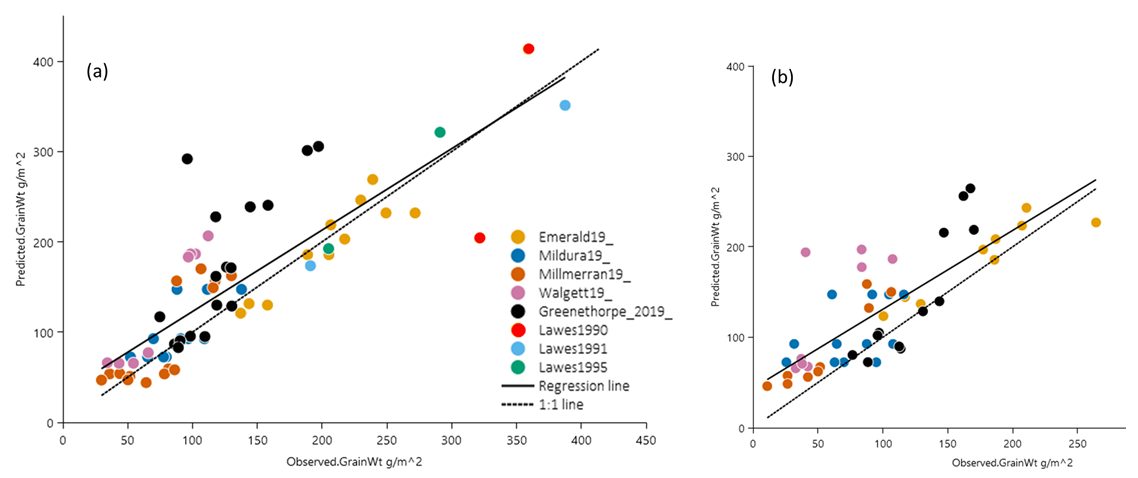 Figure 2. Predicted vs observed grain yield (a) desi and (b) kabuli cultivars, across historical data and 2019 regional trials.
Figure 2. Predicted vs observed grain yield (a) desi and (b) kabuli cultivars, across historical data and 2019 regional trials.
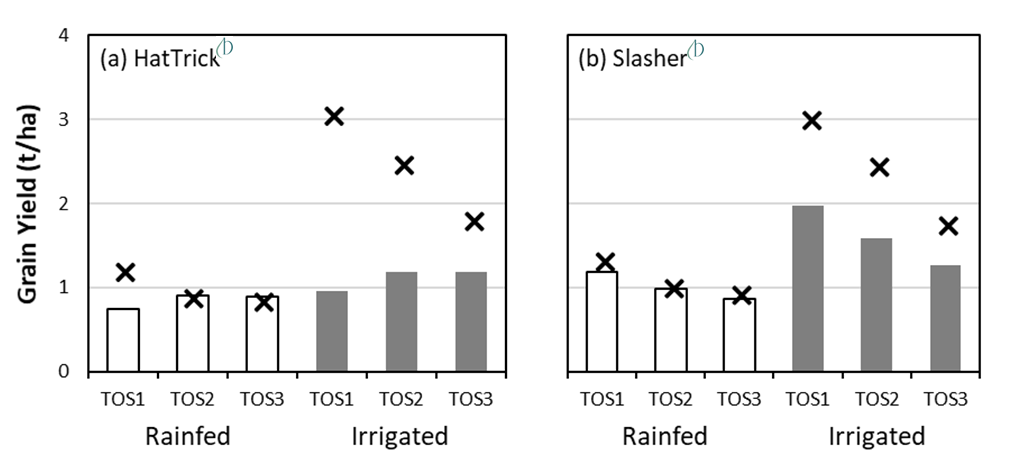 Figure 3. Measured grain yield (bars) and APSIM simulated grain yield (crosses) for the desi cultivars (a) PBA HatTrick and (b) PBA Slasher across three times of sowing (TOS) at Greenethorpe, 2019. Sowing dates were 30-April, 21-May, 12-Jun. Standard error is ≤ 0.1 t/ha for all measured yield data.
Figure 3. Measured grain yield (bars) and APSIM simulated grain yield (crosses) for the desi cultivars (a) PBA HatTrick and (b) PBA Slasher across three times of sowing (TOS) at Greenethorpe, 2019. Sowing dates were 30-April, 21-May, 12-Jun. Standard error is ≤ 0.1 t/ha for all measured yield data.
3. Regional field trial results
Despite the tendency of early sown crops to have larger yield gaps as discussed above, early sowing still achieved the best grain yield in our regional field trials in 2019 for at least some cultivars at each location (Figure 4). Our earliest sowing dates in southern NSW were not as early as the earliest sowing date of Richards et al. (2020) who observed lower grain yield in crops sown on the 15th of April compared to the 30-April in southern NSW, also in 2019. The focus of our final activity for this project was understanding the optimum flowering time to avoid frost and heat shock and maximise grain yield.
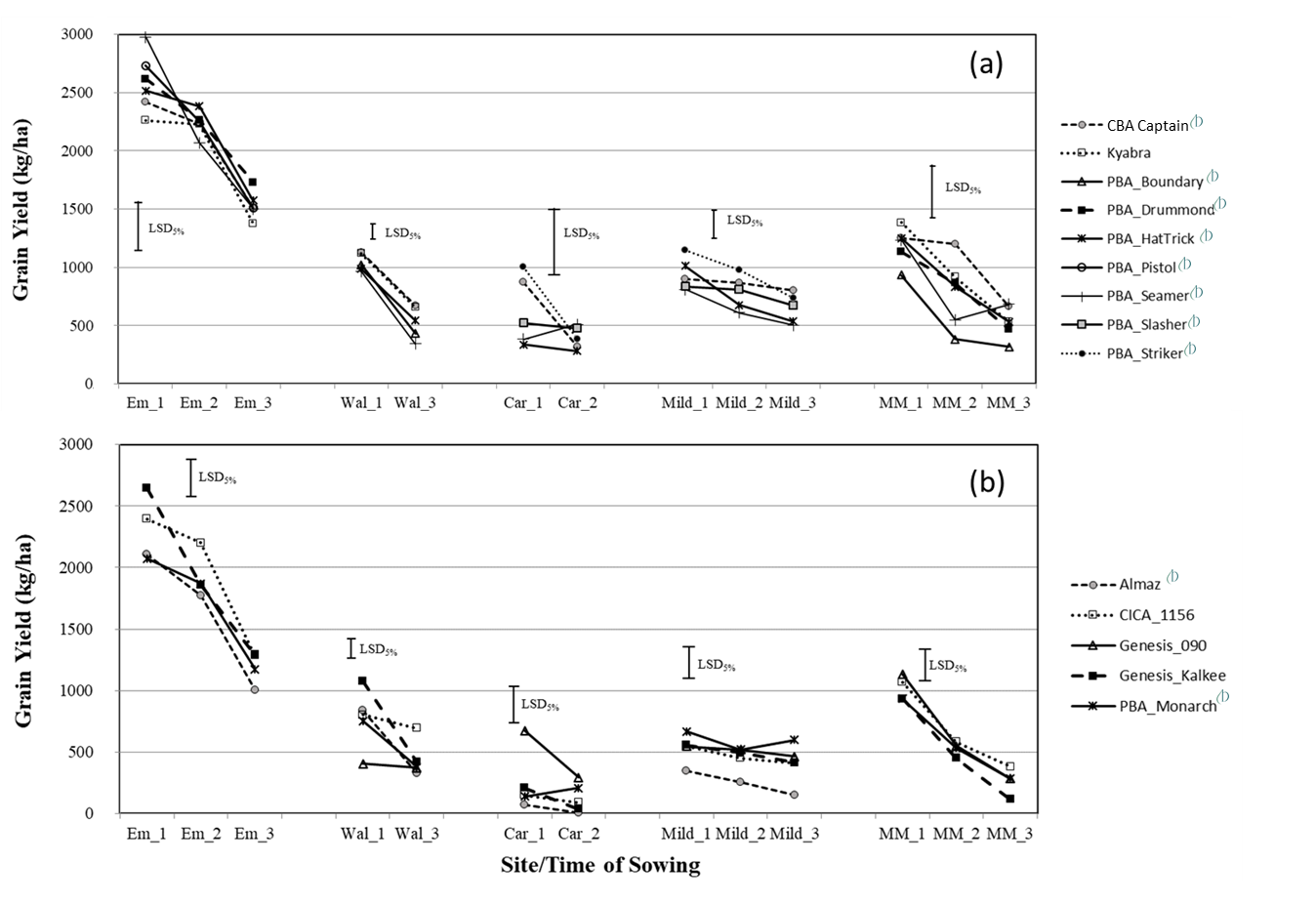 Figure 4. Grain yield vs time of sowing and location for (a) desi chickpea, and (b) kabuli chickpea from three sowing dates in five rainfed experiments in 2019. Sites and sowing dates were: Em = Emerald (10-May, 3-June, 27 June), Wal = Walgett (21-May, 28-Jun), Car = Caragabal (8-May, 17-Jun), Mild = Mildura (1-May, 18-May, 7-Jun), MM = Millmerran (17-Jun, 2-Jul, 15-Jul). Only two sowing dates were achieved at Caragabal due to low soil moisture and lack of rainfall during the sowing window. The second sowing date at Walgett for desi and kabuli chickpea were destroyed by wild pigs prior to emergence.
Figure 4. Grain yield vs time of sowing and location for (a) desi chickpea, and (b) kabuli chickpea from three sowing dates in five rainfed experiments in 2019. Sites and sowing dates were: Em = Emerald (10-May, 3-June, 27 June), Wal = Walgett (21-May, 28-Jun), Car = Caragabal (8-May, 17-Jun), Mild = Mildura (1-May, 18-May, 7-Jun), MM = Millmerran (17-Jun, 2-Jul, 15-Jul). Only two sowing dates were achieved at Caragabal due to low soil moisture and lack of rainfall during the sowing window. The second sowing date at Walgett for desi and kabuli chickpea were destroyed by wild pigs prior to emergence.
4. Variation of optimum flowering window, sowing date and potential yield across the northern region
Our ultimate aim was to use APSIM to show how flowering time (measured as the appearance of the first flower) varies with sowing date across the northern region. In addition, we linked this information with water-limited potential yield and an assessment of relative frost/heat risk, to help growers understand when they should be sowing chickpea to achieve maximum grain yield. The data is presented in a series of charts (Figure 5-10). Due to the number of locations we have simulated, data for each crop or subspecies is presented across two pages, with the more northern sites on the first page, and locations in central and southern NSW presented on the second page. Graphs for Emerald and Mildura are presented on a separate page as they have different optimum sowing periods to most other locations, with Dalby and Meandarra on the final page of graphs as a late addition for these updates in 2021.
For ease of presentation we have presented results for one cultivar for each chickpea type (i.e. PBA HatTrick for desi chickpeas and Almaz for kabuli chickpeas). If quicker/slower maturing cultivars are chosen by growers then sowing date should be adjusted to be slightly later or earlier. Local knowledge can be used in the interim to decide whether alternative cultivars will flower earlier or later than our simulated cultivars. It should be noted that the flowering benchmark used in this study is the appearance of the first flower on 50% of plants, which can occur much earlier than the date a crop is flowering prolifically and is not always easy to identify in the field.
Interpreting the potential yield graphs
Potential yield is ‘water-limited’: i.e. a simulated or predicted yield that uses the historical rainfall and available soil water, but assumes that frost, diseases, pests and nutritional disorders have not affected yield. As discussed above, the model does account for the effect of cool temperatures on flower pollination/abortion (e.g. Clarke and Siddique, 2004) by delaying the beginning of pod-set, so the emphasis herein is on the risk of intermittent frost events that may cause yield-limiting damage to floral structures and developing pods. In the following figures, the box and whisker plots have a small black line which indicates the median yield. The yield from 50% of years fall inside the box (i.e. yields from 10 years, with five years either side of the median yield), and the box whiskers represent 1.5 times the value of the adjacent quartile (i.e. between the median and the edge of the box), while grey dots represent outliers beyond this range.
Determining optimal sowing date
In the following figures, a shaded box is used to connect three-graph sets from the same location showing the predicted optimal time of flowering and pod initiation. The beginning of this ‘optimum flowering window’ is determined by assuming that the earliest flower needs to appear in the last fortnight when relative frost risk is still above 20% (i.e. approximately one day with a minimum temperature of 0°C in the week), as additional experiments suggest that the most sensitive growth stage to stress possibly falls 100 degree days later than the appearance of the first flower (Dreccer et al., 2020). The end of the optimum flowering window is the point when relative heat risk of 20% is avoided, or when 5 weeks have elapsed since the window opened. An arrow has been inserted in the week where average temperature increases above 15 degrees (and the risk of cool temperature flower abortion is reduced), to help demonstrate when pod-set is likely to begin. In the middle graph of each set it is possible to determine which sowing dates can be used to achieve the optimal flowering dates, by referring across to the y-axis. Potential yield data to the left of the optimum flowering window are at high risk of not being achieved due to frost risk.
Additional important notes
- These simulations were conducted using an average sowing depth of 5cm. The effect of sowing depth on chickpea phenology may vary across the northern region, and further study is needed to determine how much earlier deep-sown crops should be sown to achieve the flowering dates presented here.
- Frost risk varies markedly within short distances. Data in these figures may not apply to farms that are closely situated to the locations for which we have provided simulations, due to differences in elevation and aspect between met stations and individual fields.
- Simulations have been prepared using 60-90 mm of stored soil water prior to sowing, depending on location (i.e. 60 mm south of Dubbo, 90 mm north of Dubbo). Water-limited potential yield will vary from what we have presented, if more or less water is available at sowing.
Desi Chickpeas – QLD/NSW
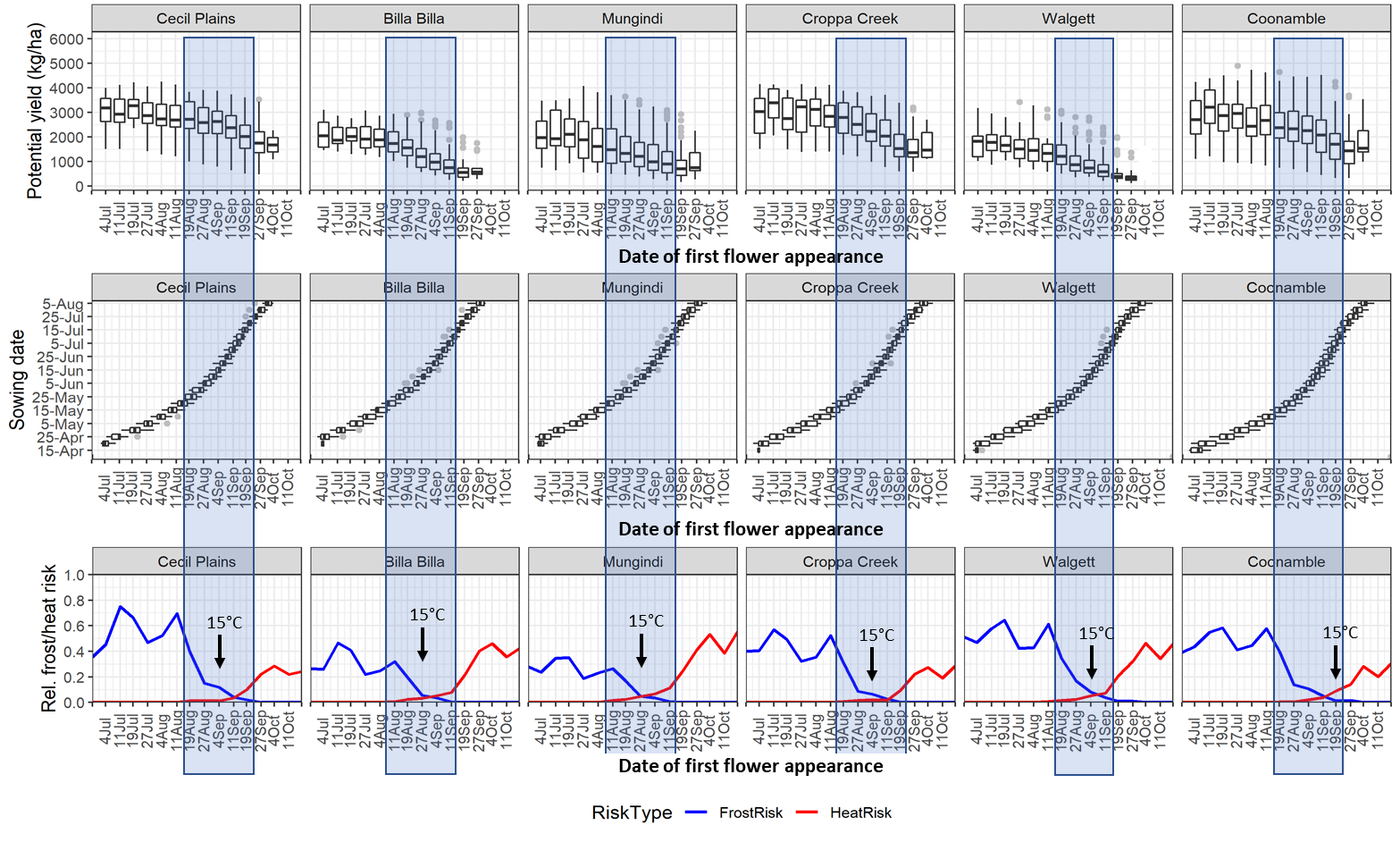 Figure 5. Water-limited potential yield, sowing date and relative frost/heat risk, plotted against the date of first flower appearance for PBA HatTrick at six environments in QLD and northern NSW. Shaded area represents the predicted optimum window for appearance of first flowers. Arrows and ‘15°C’ mark the first week that has an average daily temperature ≥15°C in the second half of the year, i.e. when conditions become favourable for pod-set.
Figure 5. Water-limited potential yield, sowing date and relative frost/heat risk, plotted against the date of first flower appearance for PBA HatTrick at six environments in QLD and northern NSW. Shaded area represents the predicted optimum window for appearance of first flowers. Arrows and ‘15°C’ mark the first week that has an average daily temperature ≥15°C in the second half of the year, i.e. when conditions become favourable for pod-set.
Desi Chickpeas – NSW
 Figure 6. Water-limited potential yield, sowing date and relative frost/heat risk, plotted against the date of first flower appearance for PBA HatTrick at six environments in NSW. Shaded area represents the predicted optimum window for appearance of first flowers. Arrows and ‘15°C’ mark the first week that has an average daily temperature ≥15°C in the second half of the year, i.e. when conditions become favourable for pod-set.
Figure 6. Water-limited potential yield, sowing date and relative frost/heat risk, plotted against the date of first flower appearance for PBA HatTrick at six environments in NSW. Shaded area represents the predicted optimum window for appearance of first flowers. Arrows and ‘15°C’ mark the first week that has an average daily temperature ≥15°C in the second half of the year, i.e. when conditions become favourable for pod-set.
Kabuli Chickpeas – QLD/NSW
 Figure 7. Water-limited potential yield, sowing date and relative frost/heat risk, plotted against the date of first flower appearance for Almaz at six environments in QLD and northern NSW. Shaded area represents the predicted optimum window for appearance of first flowers. Arrows and ‘15°C’ mark the first week that has an average daily temperature ≥15°C in the second half of the year, i.e. when conditions become favourable for pod-set.
Figure 7. Water-limited potential yield, sowing date and relative frost/heat risk, plotted against the date of first flower appearance for Almaz at six environments in QLD and northern NSW. Shaded area represents the predicted optimum window for appearance of first flowers. Arrows and ‘15°C’ mark the first week that has an average daily temperature ≥15°C in the second half of the year, i.e. when conditions become favourable for pod-set.
Kabuli Chickpeas – NSW
 Figure 8. Water-limited potential yield, sowing date and relative frost/heat risk, plotted against the date of first flower appearance for Almaz at six environments in NSW. Shaded area represents the predicted optimum window for appearance of first flowers. Arrows and ‘15°C’ mark the first week that has an average daily temperature ≥15°C in the second half of the year, i.e. when conditions become favourable for pod-set.
Figure 8. Water-limited potential yield, sowing date and relative frost/heat risk, plotted against the date of first flower appearance for Almaz at six environments in NSW. Shaded area represents the predicted optimum window for appearance of first flowers. Arrows and ‘15°C’ mark the first week that has an average daily temperature ≥15°C in the second half of the year, i.e. when conditions become favourable for pod-set.
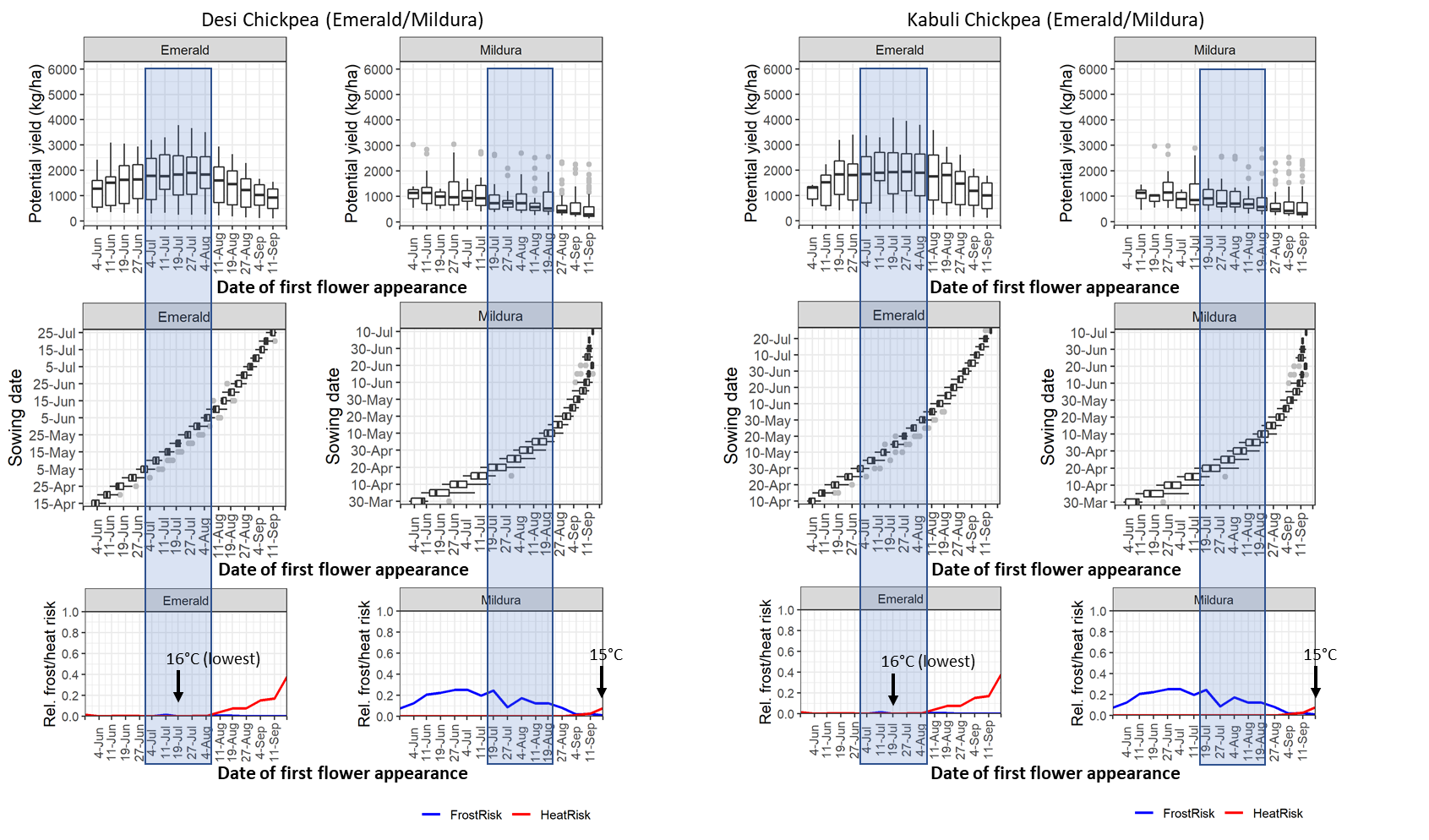 Figure 9. Water-limited potential yield, sowing date and relative frost/heat risk, plotted against the date of first flower appearance for PBA HatTrick and Almaz at Emerald and Mildura. Shaded area represents the predicted optimum window for appearance of first flowers. Arrows and ‘15°C’ mark the first week that has an average daily temperature ≥15°C in the second half of the year, i.e. when conditions become favourable for pod-set.
Figure 9. Water-limited potential yield, sowing date and relative frost/heat risk, plotted against the date of first flower appearance for PBA HatTrick and Almaz at Emerald and Mildura. Shaded area represents the predicted optimum window for appearance of first flowers. Arrows and ‘15°C’ mark the first week that has an average daily temperature ≥15°C in the second half of the year, i.e. when conditions become favourable for pod-set.
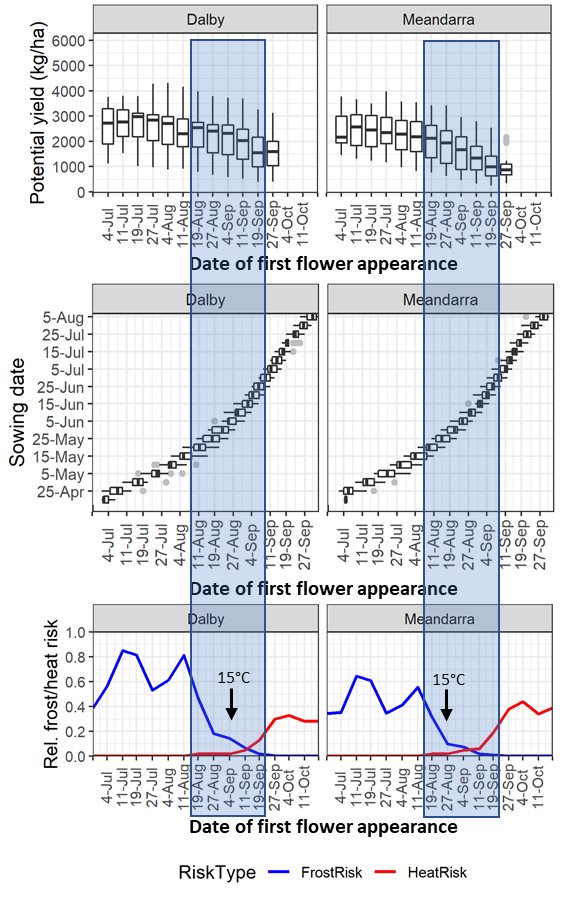 Figure 10. Water-limited potential yield, sowing date and relative frost/heat risk, plotted against the date of first flower appearance for PBA HatTrick at Dalby and Meandarra. Shaded area represents the predicted optimum window for appearance of first flowers. Arrows and ‘15°C’ mark the first week that has an average daily temperature ≥15°C in the second half of the year, i.e. when conditions become favourable for pod-set.
Figure 10. Water-limited potential yield, sowing date and relative frost/heat risk, plotted against the date of first flower appearance for PBA HatTrick at Dalby and Meandarra. Shaded area represents the predicted optimum window for appearance of first flowers. Arrows and ‘15°C’ mark the first week that has an average daily temperature ≥15°C in the second half of the year, i.e. when conditions become favourable for pod-set.
Trends and observations
Water-limited potential yield declines rapidly in spring with later sown crops, particularly in the more northern environments.
Within the optimum flowering window, yield declined up to 300 kg/ha per week that first flower appearance was delayed in the most extreme situations (e.g. Cecil Plains, Billa Billa (Figure 5) and Meandarra (Figure 10)). Although the model showed a tendency to over-predict grain yield on early sowing dates in some environments (Figure 3), yield was lower for later sowing dates in the field trials (Figure 11), where grain yield declined at between 60 and 225 kg/ha per week that the first flower appearance was delayed, depending on location and time-of-sowing. While it can be difficult to determine if yield reductions are due to heat stress, water stress or simply the shorter growing season experienced by late sown crops, delayed flowering into warmer weather conditions reduced yield in the 2019 field trials and the simulations. However in wet seasons delayed sowing may not have the same yield penalty, so further research is necessary to investigate the relationship between time of sowing and yield across a range of locations and seasons.
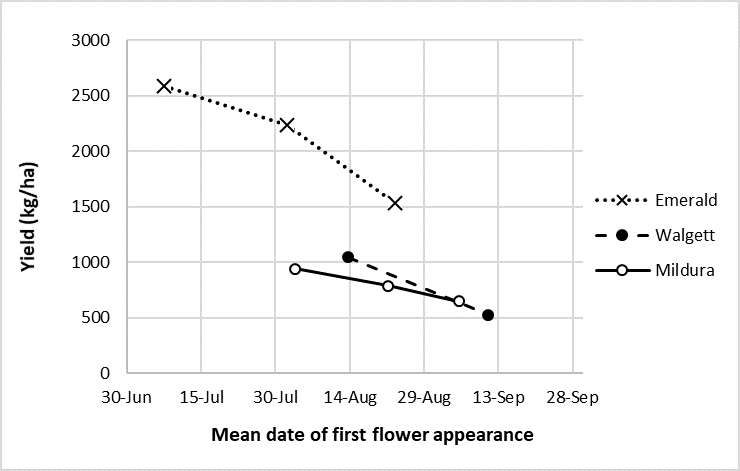 Figure 11. Mean grain yield vs mean date of first flower appearance across 5 desi chickpea varieties from three ‘time-of-sowing’ field experiments conducted in 2019. Markers (cross or circles) represent data generated from a single sowing date. The Caragabal and Millmerran experiments were not included due to uneven emergence that prevented accurate assessment of plot flower appearance.
Figure 11. Mean grain yield vs mean date of first flower appearance across 5 desi chickpea varieties from three ‘time-of-sowing’ field experiments conducted in 2019. Markers (cross or circles) represent data generated from a single sowing date. The Caragabal and Millmerran experiments were not included due to uneven emergence that prevented accurate assessment of plot flower appearance.
It is unclear whether ultra-early sowing could provide even greater yield advantages in a dry season.
While most northern sites reached the 15°C threshold for pod-set 2-3 weeks after the beginning of the optimum flowering window, the more southern sites had a larger gap (e.g. 5 weeks at Wagga and 9 weeks at Mildura). While early sown crops may not set pods for many weeks after the first flower appears, the increased biomass development and/or root growth that occurs during this delay may be important for maximising grain yield in a dry season. While Richards et al. (2020) identified a yield penalty associated with ultra-early sowing in southern NSW, their results were obtained in different environments to those of southern QLD and northern NSW. Further research is recommended in both high and low frost-risk environments with a range of stored soil water to understand how long this infertile flowering phase can continue before significant yield loss occurs. This research would help define the optimum flowering window and sowing dates with more precision for a range of environments and seasons.
Frost risk varies over short distances within the landscape, so individual farms or paddocks may have different risk profiles (and optimum sowing dates) to those presented here.
Recent work by AMPs Research in wheat has shown that the top sections of some sloping paddocks on the Liverpool Plains can be sown 4-6 weeks earlier due to lower frost risk. Similarly, it is important to understand that the charts presented here may not be applicable to nearby farms or paddocks due to differences in local topography. For example, our first simulations for the Liverpool Plains used the Gunnedah Resource Centre meteorological station, but we later realised this data was not representative of most farms in the Gunnedah district. We then compared these simulations with the equivalent data from nearby Breeza (side-by-side comparison in Figure 6 or 8) showing a much greater frost risk at Breeza compared to the Resource Centre for the same dates in August. Growers should seek independent advice on frost risk for their individual locality and be careful about making large changes to their normal sowing dates based on data presented here.
Kabuli cultivars are generally slower maturing than desi cultivars
Growers swapping between the two types for the first time need to be mindful of sowing Kabuli chickpeas earlier than desi chickpeas, to flower in the same optimal flowering window.
Extremely early and ultra-late sown crops have the lowest water-limited potential yield.
Some growers in southern NSW are experimenting with spring-sown chickpea to avoid the overly wet, winter growing conditions they encounter in good seasons. However, they may struggle to generate acceptable grain yield unless they are in a cool environment and/or have a genuinely full profile of moisture, and experience good spring rainfall. Further simulations could be conducted to investigate these possibilities.
Effect of deep sowing and water stress on optimum sowing date
As discussed above, the predictions of optimum sowing date in Figures 5-10 assume a sowing depth of 5cm. As chickpea is often sown deeper than this, it is possible growers may need to take this into account when deep sowing, by sowing earlier than the sowing dates presented here to achieve the same flowering date. However, experiments in Western Australia on sandy soils have shown negligible differences for emergence date and flowering date for an early-season chickpea experiment sown at 5 and 20 cm (Rich and Lawes, 2020). Additional anecdotal evidence suggests that while the delay may be small in a warm environment (e.g. Central QLD), it may be larger in cooler environments such as the Liverpool Plains. A rule of thumb used by some agronomists is to allow one days delay in emergence for every additional centimetre of sowing depth, however it is possible that deep sown seedlings may be accumulating ‘heat units’ toward their phenological development while underground, so delayed emergence may not lead to an equivalent delay in the appearance of the first flower. More research is necessary to determine the effect of sowing depth on emergence date and phenology processes across QLD and NSW pulse production regions. Growers and agronomists are advised to keep records on this information for individual fields, as it probably varies between soil types and location.
Additional experiments from 2019 also showed that flowering date sometimes occurred earlier in rainfed plots compared to irrigated plots, suggesting that water stress may hasten reproductive processes. The trend was not consistent across locations and cultivars, but in the most extreme case (Genesis 90 at Greenethorpe) flowering processes were 10-19 days earlier in rainfed treatments compared to irrigated treatments, while at Gatton no differences were detected in flowering date for any cultivar but podding date was 4-12 days earlier in rainfed treatments of both PBA HatTrick and Genesis 90. The degree of water stress was probably different between these locations, which would explain the variable results. Further work is needed to determine how different severity of water stress might impact on the occurrence of the optimal flowering window for specific situations and soil types. Wet conditions might reasonably be expected to delay flowering (and hence require earlier sowing to achieve the same flowering date) as has been observed in crops such as wheat. However, disease control may be more difficult in conjunction with early sowing in wet seasons, so optimum sowing date from a grower’s perspective may ultimately not differ greatly between wet and dry years.
Conclusions
The use of crop models in conjunction with field experiments has successfully transformed agronomic practices across Australia in the last three decades. The investment made in improving modelling capacity of chickpea through this project has increased confidence in the prediction of flowering date, potential yield, optimum flowering windows and the sowing dates needed to achieve them. We have also demonstrated the need for further research into cultivar response to early sowing, understanding the optimum length of the infertile flowering phase, and improving our understanding on the effect of water stress and sowing depth on phenology.
The process of investigating experiments using the models also provides direction for future research by highlighting the scientific ‘bottlenecks’ that improved prediction and understanding of crop performance. Additional research is needed across additional seasons to ensure that the predictions of crop performance apply to a range of seasonal conditions, not just the extreme drought conditions experienced during 2019. Model testing in additional environments and seasons will undoubtedly highlight further strategic research priorities that could be addressed to benefit Australian grain farmers into the future.
Acknowledgements
The research undertaken as part of this project is made possible by the significant contributions of growers through both trial cooperation and the support of the GRDC, and the authors would like to thank them for their support. CSIRO, NSWDPI, SARDI, QDAF, USYD, UQ-QAAFI, The Australian Federal Government, QLD, NSW and SA State Governments are also acknowledged for directly and indirectly contributing to project funding. We would also like to thank Zvi Hochman and Heidi Horan (CSIRO), Richard McCallum, Mark Richards and Kirsty Hobson(NSWDPI), Helen Bramley and Josie Clarke (University of Sydney) for their contributions to the project that were not reported in this paper. We thank Paul McIntosh (Pulse Australia and the Australian Herbicide Resistance Initiative) for assisting with disease control protocols, and Neil Huth (CSIRO) for assisting with APSIM model development. We also acknowledge the incredible work carried out by the many technical staff from many organisations in successfully planning and conducting the extensive field trial program, which was instigated at short notice.
Important disclaimer
CSIRO and GRDC advise that the information contained in this publication comprises general statements based on scientific research. The reader is advised and needs to be aware that such information may be incomplete or unable to be used in any specific situation. No reliance or actions must therefore be made on that information without seeking prior expert professional, scientific and technical advice. To the extent permitted by law, CSIRO, GRDC and the partner organisations listed above (including their employees and consultants) exclude all liability to any person for any consequences, including but not limited to all losses, damages, costs, expenses and any other compensation, arising directly or indirectly from using this publication (in part or in whole) and any information or material contained in it.
References
Clarke, H. J. and Siddique, K. H. M. (2004). Response of chickpea genotypes to low temperature stress during reproductive development. Field Crops Research, 90, 323-334.
Daba, K., Warkentin, T. D., Bueckert, R., Todd, C. D., & Tar’an, B. (2016). Determination of photoperiod-sensitive phase in chickpea (Cicer arietinum L.). Frontiers in Plant Science, 7, 478.
Dreccer, M.F., Sadras, V., Lake, L., Peake, A.S., Lee Long, I. et al. (2020). Appendix B: Understanding the critical stage for yield formation in chickpea and lentil in response to abiotic stress. In Peake A.S. et al. (Eds) ‘Final Report to GRDC project CSP1904-005RXT: The adaptation of pulses (chickpea and lentil) across the northern grains region’. CSIRO Agriculture and Food, ACT, Australia.
Rich, S. and Lawes R. (2020) Sowing flexibility of chickpea and lentil in the Western Australian farming system. GRDC Updates, February 2020, Perth.
Richards, M., Maphosa, L., Presto, A., Napier, T., Hume, I. (2020). Pulse adaptation – optimising grain yield of chickpea and lentils. GRDC Northern Region Updates, 2019.
Srinivasan, A., Johansen, C., & Saxena, N. P. (1998). Cold tolerance during early reproductive growth of chickpea (Cicer arietinum L.): characterization of stress and genetic variation in pod set. Field Crops Research, 57(2), 181-193.
Warren, A., Graham, N., Raman, R., Hobson, K. (2019). The physiology and genetics of cold temperatures in chickpeas – what do we know and where is the research heading? GRDC Northern Region Updates, 2019.
Whish, J., Peake, A.S., Rodriguez, D., Swan, T., Richards, M., et al. (2020). Appendix F: Chickpea Phenological Key. In Peake A.S. et al. (Eds) ‘Final Report to GRDC project CSP1904-005RXT: The adaptation of pulses (chickpea and lentil) across the northern grains region’. CSIRO Agriculture and Food, ACT, Australia.
Contact details
Allan Peake
CSIRO Agriculture and Food
PO Box 102, Toowoomba, 4350
Ph: 07 4571 3212
Email: allan.peake@csiro.au
Varieties displaying this symbol beside them are protected under the Plant Breeders Rights Act 1994.
GRDC Project Code: CSP1904-005RXT,
